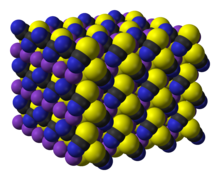
| |

| |
| Names | |
|---|---|
| Other names
Potassium sulfocyanate
Potassium isothiocyanate (tautomeric form) Potassium thiocyanide Potassium rhodanide | |
| Identifiers | |
3D model (JSmol)
|
|
| 3594799 | |
| ChEBI | |
| ChemSpider | |
| ECHA InfoCard | 100.005.792 |
| EC Number |
|
| 21362 | |
PubChem CID
|
|
| RTECS number |
|
| UNII | |
CompTox Dashboard (EPA)
|
|
| |
| |
| Properties | |
| KSCN | |
| Molar mass | 97.181 g mol−1 |
| Appearance | Colorless deliquescent crystals |
| Odor | Odorless |
| Density | 1.886 g/cm3 |
| Melting point | 173.2 °C (343.8 °F; 446.3 K) |
| Boiling point | 500 °C (932 °F; 773 K) (decomposes) |
| 177 g/100 mL (0 °C) 217 g/100 mL (20 °C) | |
| Solubility | acetone: 21.0 g/100 mL ethanol: soluble |
| −48.0·10−6 cm3/mol | |
| Hazards | |
| GHS labelling: | |
 
| |
| Warning | |
| H302, H312, H318, H319, H332, H412 | |
| P261, P264, P270, P271, P273, P280, P301+P312, P302+P352, P304+P312, P304+P340, P305+P351+P338, P310, P312, P322, P330, P337+P313, P363, P501 | |
| NFPA 704 (fire diamond) | |
| Lethal dose or concentration (LD, LC): | |
LD50 (median dose)
|
854 mg/kg (oral, rat)[1] |
| Safety data sheet (SDS) | ICSC 1088 |
| Related compounds | |
Other anions
|
Potassium cyanate Potassium cyanide |
Other cations
|
Sodium thiocyanate Ammonium thiocyanate |
Except where otherwise noted, data are given for materials in their standard state (at 25 °C [77 °F], 100 kPa).
| |
Potassium thiocyanate is the chemical compound with the molecular formula KSCN. It is an important salt of the thiocyanate anion, one of the pseudohalides. The compound has a low melting point relative to most other inorganic salts.
- ^ "Potassium thiocyanate [NF]". chem.sis.nlm.nih.gov. Archived from the original on 20 April 2018. Retrieved 19 April 2018.
